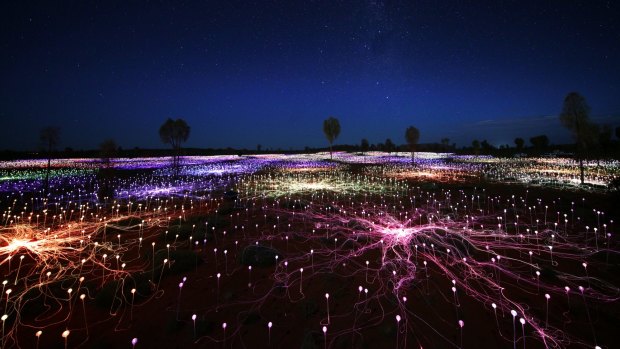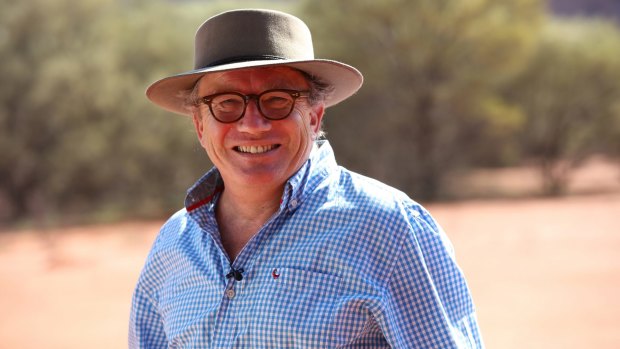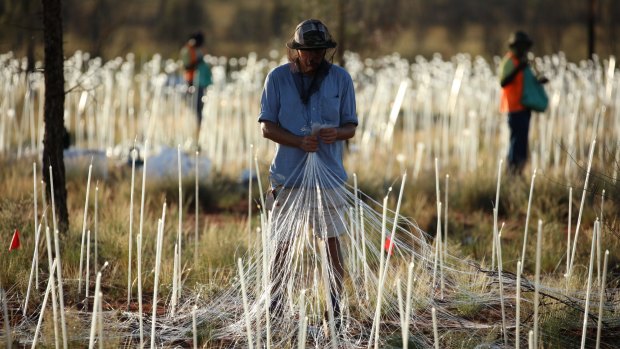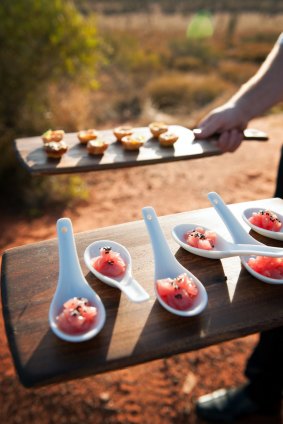This was published 7 years ago
Uluru Field of Light installation by Bruce Munro: Field of Light comes home
By Katrina Lobley

After 24 years, Bruce Munro's vision has been realised at Uluru.Credit: Mark Pickthall
SPONSORED ARTICLE
Inspired by desert seeds springing into life after the rains, an English artist's vision has finally bloomed, writes Katrina Lobley.
It would be easy to think that artist Bruce Munro is all about the razzle-dazzle. After all, his latest Field of Light installation is a monumental carpet of 50,000 frosted-glass spheres on stems laid out over the blood-red sand near Uluru. The result is an immense solar-powered work sprawling over 49,000 square metres – more than double the area of the Melbourne Cricket Ground oval. As visitors delve into the artwork, which looks like a field of futuristic flowers blooming between tufts of spinifex, they're enveloped by choreographed waves of colour. Yet the British artist has been busy making sure the piece doesn't out-do its striking desert surrounds.

Munro on site at Uluru.Credit: Mark Pickthall
"The colour is incredibly important – to get that right – and also the intensity of the light," Munro says from Ayers Rock Resort, which is hosting the year-long installation. "I've gone really soft on this in terms of the lumen output" – or brightness – "simply because this sky is incredible at night and, if you have something more intense, then you're fighting and I wanted to be in balance with it. We tempered it right from the beginning.
"There is a sense of spectacle in that it's a vast installation but it's meant to be a meditative piece, a gentle piece, not a sort of 'wham-bam-thank-you-ma'am' piece that lights up the sky so you can't see anything else."
Field of Light began life as jottings in a sketchbook in 1992. Munro had spent eight years in Sydney working all sorts of jobs – as a bricklayer, an aerobics instructor and a maker of illuminated displays – before he and his fiancée (now wife) Serena set off on a four-month road trip to Australia's must-see sights before returning to England. While camping at Uluru, he noted down the idea of an installation that would bloom at night, much like dormant seeds bursting forth after rain.

One of the artwork's handlers/installers.Credit: Mark Pickthall
"I wanted to express that feeling of joy – a mixture of joy and serenity," he says. "This was a private jotting – it wasn't something I ever imagined would go further than the sketchbook."
He photocopied the half-dozen pages, sticking them on his studio walls in England as he persevered with a painting career that went nowhere. When a friend asked about the drawings, Munro told him it was a concept he'd had for an expression of the landscape at Uluru.
"He looked at me and said, 'C'mon, get real, you're not going to do something like this. It looks very expensive.'"

The Sounds of Silence experience starts with sunset drinks in the desert overlooking Uluru and Kata Tjuta, and includes a buffet dinner as well as some post-prandial stargazing.
The friend was right about that but his remark sparked an urge for Munro to realise the concept. And when he started working with fibre optics, it dawned on him that he'd found the perfect way to express his big idea. He started with a small version – just 10,000 illuminated stems – for a department store's window display, which attracted the attention of the Victoria and Albert Museum. It hosted another version in its garden for three months.
"The real dream was to put it in a landscape," says Munro. So he installed Field of Light in his own backyard, a clover field in Wiltshire.
"I needed a field because I thought secretly if I have a field I don't have to get anybody else's permission to do it," Munro says. "We'd just bought this house and were slightly on the back end of the mortgage. Instead of doing the wallpaper and paintwork and whatever else, the money got diverted into my Field of Light. I wasn't the most popular fellow for a while."
Field of Light has since been seen at sites across the United Kingdom, United States and Mexico. In Arizona, theoretical physicist and Nobel laureate Frank Wilczek even declared he got an "inkling of what thought looks like" after seeing the work. But it was a phone call from ABC Radio in Alice Springs that started the long process of bringing the now-famous Field of Light back to where it all began. Ray Stone, an executive at Voyages Indigenous Tourism Australia, which operates Ayers Rock Resort, heard Munro's interview and phoned him.
"The idea of actually bringing it home for me was like a dream come true," says Munro. "But when I got here and saw the vastness of the space again, I said, 'There's no point in doing it unless we do it properly – it's got to be of a certain scale to work with the space.'"
The project gained serious momentum once Qantas agreed to transport the 15,000 tonnes of lights from Munro's studio to the remote outback. Munro also felt anxious about imposing a Western artwork on a landscape so deeply entwined with indigenous culture.
"This is really just me trying to express how much Uluru changed me," he says. "I'm not being corny but it did change my life. There's not a day that I don't get up in the morning and say thank you to Uluru."
For more information visit www.ayersrockresort.com.au
DESERT DINING
Outback dining has come a long way from damper and billy tea. During your Red Centre stay, you may savour anything from a pizza made with smoked kangaroo, emu strips, mushroom, onion and bush tomato, to a cloth-aged cheddar soufflé served atop a sand dune with views of Uluru and Kata Tjuta. There is a lot more on the menu at the dozen different dining outlets scattered around Ayers Rock Resort.
Graze on sophisticated tapas such as blue cheese arancini at Sails in the Desert's Walpa Bar, or throw a barramundi on the barbie at Outback Pioneer BBQ and Bar. Spicy stir-fries are served up at Ayers Wok Noodle Bar, while the old-school milkshakes at Kulata Academy Café are created by Aboriginal trainees. More interested in traditional tastes? A bush tucker tour offers insights into the food sources found by the Anangu. Alternatively, go culinary adventuring without leaving the resort: Indigenous flavours are woven through every menu, including the cocktails designed by Sails in the Desert's mixologist, Ty Bennett. Try his caprioska made with strawberry, Thai basil and quandong, a native sour plum. For a meal to remember, there's dinner under the stars. The Sounds of Silence experience starts with sunset drinks in the desert overlooking Uluru and Kata Tjuta, and includes a buffet dinner as well as some post-prandial stargazing. The Tali Wiru dinner amid the sand dunes turns up the romance factor. Just 20 guests at a time can enjoy this intimate experience, which starts with sunset canapés. On the menu are dishes such as pan-seared scallops with finger lime and emu prosciutto crostini and a wild rosella verrine. After dinner, a storytelling session around the fire, accompanied by a warming port or perhaps a hot chocolate infused with wattleseed, brings the evening to a perfect close. - Ute Junker
This article brought to you in association with Ayers Rock Resort and Tourism NT.
Sign up for the Traveller Deals newsletter
Get exclusive travel deals delivered straight to your inbox. Sign up now.